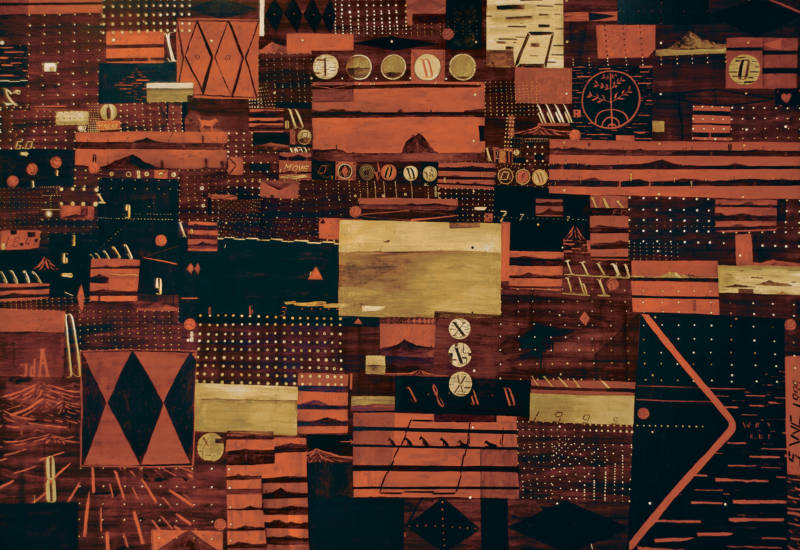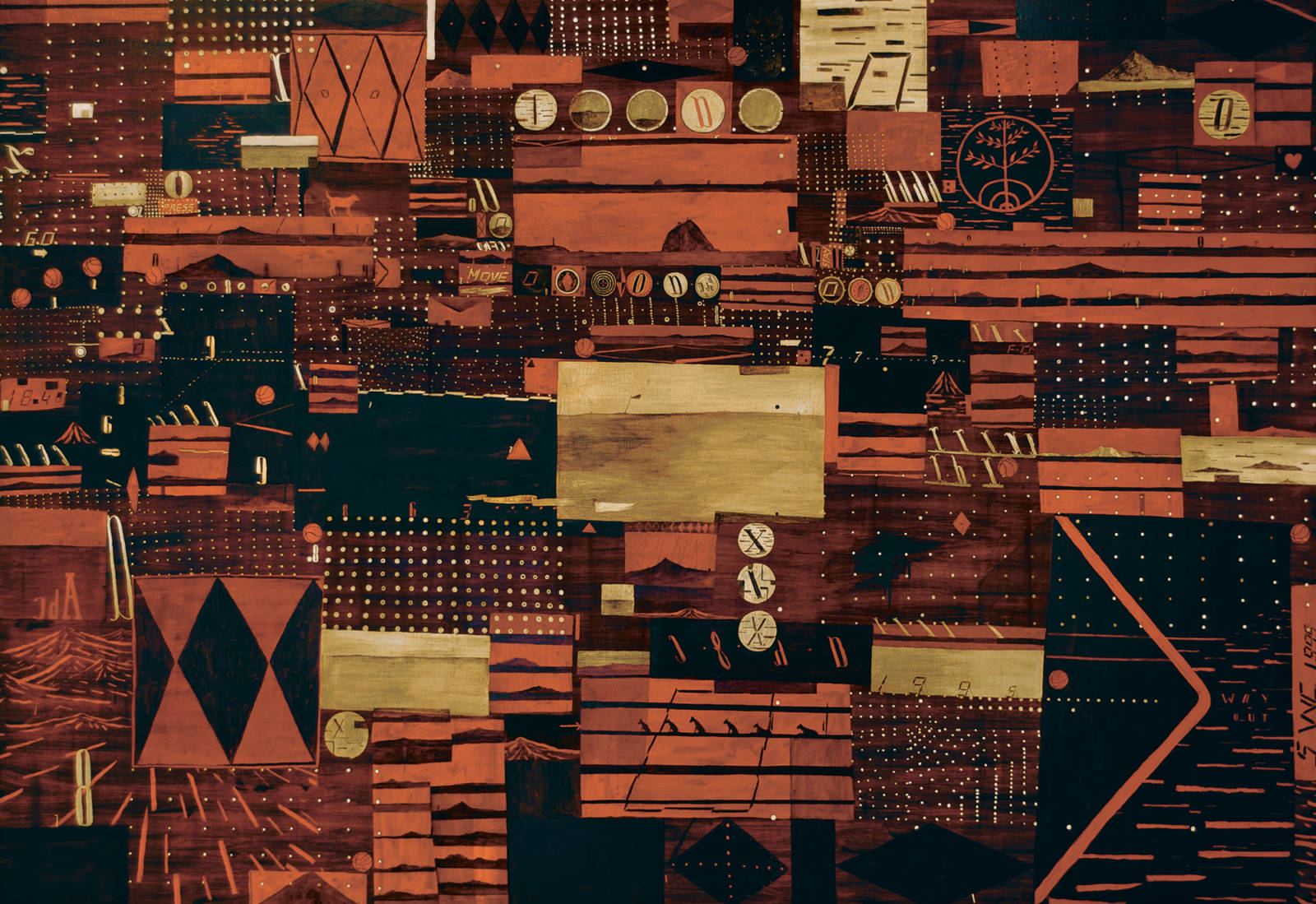COTTON, Shane;
The Plant
1995
Oil on canvas
1903 x 2750mm

The following two texts were written for Te Huringa/Turning Points and reflect the curatorial approach taken for that exhibition.
Peter Shaw
This much-exhibited work takes a bird’s-eye view that invites the viewer to ‘read’ its surface as one might read a map. Such a method of recording land holdings was wholly antithetical to Māori notions of recording tenure.
A direct contemporary reference to land alienation can be deciphered if one looks at the lower right section of the work. Here, on its side, is an envelope. At the apex of the fold are the words ‘WAY OUT’, a bitter comment on the then National government’s 1993 Fiscal Envelope which proposed, without prior consultation with iwi Māori, a non-negotiable package for the final settling of Treaty of Waitangi claims, with a ceiling of $1 billion.
The year 1995 saw unprecedented levels of dissent, originating in Māori loss of patience with government handling of land grievances. Waitangi Day was a major focus, followed by the occupation of Moutoa Gardens (Pakaitore Marae) in Whanganui; the occupation of the disused Tamaki Girls’ College, Auckland; the occupation of the marae at the Whakarewarewa Arts and Crafts Institute; and another occupation by a hapū of Tainui of a hill behind the Huntly Power Station.
If one takes the title of this painting literally, it can also be viewed as the panel of a huge machine with its banks of flashing lights and instructions to ‘press’, ‘go’, or ‘move’. There are more light-hearted references to popular culture, including video games.
Shane Cotton has said of this work that it functions as ‘a system or pattern of sorts that overlaps, weaves, contains and filters different kinds of historical and indigenous information’.
Jo Diamond
The success of this painting lies in the puzzles that exist in its highly-patterned references, despite a relatively innocuous palette of pale yellows and whites, muted reds, browns and black.
For those of us Māori who identify closely with the northern rohe (tribal lands) of Ngāpuhi, the messages within it are reminders of a painful and frustrating past. The Dog Tax, for example, represented by the small and easily missed line of dog figures in the painting, is now embedded in our memories, reminding us of the efforts undertaken by government forces to oppress our tūpuna (ancestors). The heat of outrage at that punitive tax scheme which flows, lava-like, down through the generations, is obviously unabated as they burn in the heart of this artist and many other Māori alongside him.
And then there is the plant. Te Kooti Arikirangi Te Tūruki and Rongopai always spring to mind at the mention of plants in relation to Shane Cotton’s work. If the title refers to a factory, this painting extends beyond its Ringatū references into colonialist industrial capitalism, with all its negative consequences for Māori culture and land. There is a similarity between the way a woven tukutuku wall panel can convey the history of Māori people’s attachment to land and this work’s abstracted form of story-telling.
If, for example, the viewer takes this painting as an abstract landscape then some sense of cultural disruption becomes clear. Loss has occurred at the same time as change; immoral land sales and confiscations had widespread socio-cultural implications for Māori. Both Māori and non-Māori cultures failed to remain intact as compromises, conflicts and degradations of environments and people took place. This artist offers us a chance to accept that convoluted and often tragic history through the patchwork of symbols in this painting.
Exhibition History
Tirohanga Whānui: Views from the Past, Te Kōngahu Museum of Waitangi, 15 April to 15 September 2017
Te Huringa/Turning Points: Pākehā Colonisation and Māori Empowerment, Sarjeant Gallery Te Whare o Rehua, Whanganui, 8 April to 16 July 2006 (toured)
The Nervous System: Twelve Artists Explore Images and Identities in Crisis, curated by Allan Smith, City Gallery Wellington Te Whare Toi, Te Whanganui-a-Tara, 31 October to 29 November 1995
The Nervous System: Twelve Artists Explore Images and Identities in Crisis, curated by Allan Smith, Govett-Brewster Art Gallery, Ngāmotu New Plymouth, 9 September to 23 October 1995
References
Priscilla Pitts and Allan Smith (eds), The Nervous System: Twelve Artists Explore Images and Identities in Crisis (Ngāmotu New Plymouth: Govett-Brewster Art Gallery; Te Whanganui-a-Tara: City Gallery Wellington Te Whare Toi, 1995), 69.
Provenance
1995–
Fletcher Trust Collection, purchased July 1995

